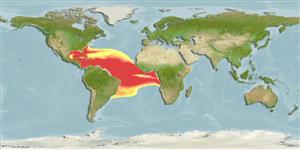Teleostei (teleosts) >
Stomiiformes (Lightfishes and dragonfishes) >
Stomiidae (Barbeled dragonfishes) > Melanostomiinae
Etymology: Eustomias: Greek, eu = good + Greek, stoma = mouth (Ref. 45335).
Environment: milieu / climate zone / depth range / distribution range
Ecology
Marine; bathypelagic; depth range 0 - 2000 m (Ref. 37039), usually 0 - 200 m (Ref. 37039). Deep-water
Western Atlantic: including the Antilles. Eastern Atlantic.
Size / Weight / Age
Maturity: Lm ? range ? - ? cm
Max length : 14.9 cm SL male/unsexed; (Ref. 37039)
Short description
Identification keys | Morphology | Morphometrics
Dorsal soft rays (total): 20 - 26; Anal soft rays: 33 - 38. Body slender and elongate, color black; body depth 7.5-10% SL. Head length 10.3-14.4% SL. Lower jaw about equal to length of upper jaw and is not upturned at tip. Long, tapering, protrusible snout. Chin barbel 13-40% SL. Barbel with slender stem and 2-3 terminal bulbs; distal bulb largest and bears 2 or more short, terminal filaments that are variously branched or unbranched. No deep ventral groove (Ref. 37039).
Feeds on midwater fishes (Ref. 37039).
Life cycle and mating behavior
Maturities | Reproduction | Spawnings | Egg(s) | Fecundities | Larvae
Claro, R., 1994. Características generales de la ictiofauna. p. 55-70. In R. Claro (ed.) Ecología de los peces marinos de Cuba. Instituto de Oceanología Academia de Ciencias de Cuba and Centro de Investigaciones de Quintana Roo. (Ref. 26340)
IUCN Red List Status (Ref. 130435)
Threat to humans
Harmless
Human uses
Tools
Special reports
Download XML
Internet sources
Estimates based on models
Preferred temperature (Ref.
123201): 19 - 28, mean 26.3 °C (based on 1070 cells).
Phylogenetic diversity index (Ref.
82804): PD
50 = 0.5000 [Uniqueness, from 0.5 = low to 2.0 = high].
Bayesian length-weight: a=0.00302 (0.00117 - 0.00783), b=3.12 (2.89 - 3.35), in cm total length, based on LWR estimates for this (Sub)family-body shape (Ref.
93245).
Trophic level (Ref.
69278): 4.2 ±0.73 se; based on food items.
Resilience (Ref.
120179): High, minimum population doubling time less than 15 months (Preliminary K or Fecundity.).
Fishing Vulnerability (Ref.
59153): Low vulnerability (10 of 100).
